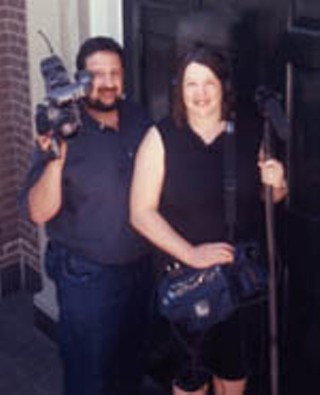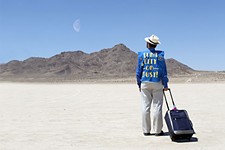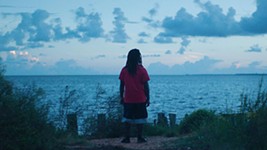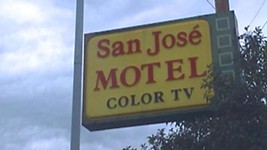Accessing Mental Illness
The Texas Documentary Tour: Bill Lichtenstein and June Peoples' 'West 47th Street'
By Anne S. Lewis, Fri., Feb. 6, 2004

Filmmaker Bill Lichtenstein had been an ABC News producer for eight years when he was diagnosed with manic depression; for the next four, life as he'd known it ground to a halt. When he emerged, successfully treated at the other end, he began to explore the way mental illness is treated in the media. "The only documentaries I could find about mental health featured people who were profoundly ill," explains Lichtenstein. "In part, that's because there's nothing more sensational than watching somebody who's psychotic: You don't know what's going to happen, and it's exciting to watch in a strange way – but it tells you nothing about the illness, what it takes to recover, or even that you can recover." Hence came West 47th Street, the doc that Lichtenstein shot over a three-year period with his wife, June Peoples, following, as "flies on the wall," the lives of four mentally ill people at various points on the road, if not to Wellville, at least to rehabilitation.
The film centers on four members of Fountain House, a 50-year-old rehabilitation center – a model of its kind nationwide – that takes up most of a block on West 47th in New York City's Hell's Kitchen. The novelty of Fountain House's concept, explains Lichtenstein, is that it intentionally tries to create a community within itself – a place to live, jobs, hobbies, a peer support group – rather than, as do most mental health programs, move people through the system as quickly as possible and back into the outside community.
Lichtenstein and Peoples, who also produce a public radio program called The Infinite Mind, hung out at Fountain House for three months before even turning on the camera – peeling potatoes in the kitchen, answering the phone, doing odd jobs – both to acclimate themselves and to let the residents and staff become acclimated to them. Cinema vérité, after all, works only if the camera can truly go unnoticed and unfettered.
They started shooting Fountain House orientation meetings for 8 weeks and 21é2 years later still had seven people on their radar screen. Ultimately, they winnowed their subjects down to the four who they thought collectively hit on the points they wanted the film to make: What serious mental illness looks like and that you can recover from it.
The Fountain House members we follow for three years of their lives are the fragile, soft-spoken Zeinab Wali, a schizophrenic whose husband took their children and fled to Egypt and who later finds a measure of security and comfort as the Fountain House resident cook; Tex Gordon, who after a lifetime of psychiatric commitments and court-ordered restraints finally tastes freedom and heads for Las Vegas for the first vacation of his life; Fitzroy Frederick, a homeless Rastafarian schizophrenic who alternates between periods of lucidity and irrational rage, street drugs, and herbal psychosis "cures," representing for the filmmakers those who – despite the system's best therapeutic efforts – are "unable to take the life ring" and eventually return to the street; and Frances Olivero, the you-couldn't-make-this-up hero of the film, a highly articulate cross-dresser who becomes an effective advocate for legislative reform and whose future is looking very bright – until he's diagnosed with terminal cancer.
Austin Chronicle: Certainly the most immediate questions that spring to mind about this project have to do with the access you were given by Fountain House and how the residents you followed adapted to the presence of the camera.
Bill Lichtenstein: We basically had access to wander around anywhere we wanted, which was really, I think, the strength of the film.
June Peoples: Of course, they weren't completely happy to have us there; there were times when we had to negotiate access. They were very tense about the meeting [of the Fountain House residents] called when Zeinab's roommate committed suicide. They weren't sure that people would be able to fully express their concerns about it if the cameras were there. We argued that unless the film was able to show that these are in fact fatal illnesses, we'd be missing a really big part of the story of mental illness. We had to do quite a bit of negotiating, but, finally, we were granted access.
BL: As far as people becoming comfortable with the camera, I think there were two stages for that to develop: First, in the beginning, there was no designated outlet, like a TV network, for the film, so it was just June and Bill walking around with a camera. In the second phase, after we'd been there for a year or two, people would ask how much film are you going to shoot, and we'd say probably about 350 hours, and they'd ask, "Well, how long is the film going to be?" Then they'd do the math in their head, and that sort of lowered the stakes of any particular scene actually appearing in the film – they just got used to us being there. And that's the point you want to get to when you're shooting, where people actually forget that you're there. The second half of the film, we begin to be the flies on the wall.
JP: For the first six months, people were more self-conscious, but we were able to bridge that gap because of the kind of work we do. When we first arrived at Fountain House, three months before we started filming, we worked in the units alongside the people, and while working with them, we would chat about the film and what our motivations were and who we were, how we wanted to show how people lived with the disorder to destigmatize the illness.
BL: Fountain House was also ambivalent about why we would follow someone like Fitzroy – someone who was, in the end, unable to grab the life ring – when there were all these other success stories that they would probably have preferred we shoot. But I think what's set this film apart from others is that it tackles someone like Fitzroy in a really sophisticated way. It says this is a tough situation: What do we do with the Fitzroys of this world, what do we do with those who won't or can't accept the help that's being lavished on them, because of their illness? We really want to leave the viewer wondering what should be done with Fitzroy. On one hand, he has schizophrenia: How can you evict someone who's psychotic for acting out? On the other hand, he can't stay in the apartment that was offered him because he was abusive to his roommate. That is the real issue of mental illness: What do we do with the Fitzroys of this world? We don't answer it, but I think that, after watching this film, when people see someone homeless and mentally ill on the street, they'll think, "Hmm, what do we need to do with this person; how can we help them?" Our goal is to take the emotion that viewers feel at the end of the film and channel it into social change.
AC: The scene with Frances, in the hospital, when his doctor is breaking the news to him – in a very awkward and blunt way – that he's got terminal cancer, had to be one of the most dramatic moments of cinema vérité, even when Frances breaks the form, turns to the camera, and says, "I'll cry later."
JP: Frances' story is one of my favorite parts of the film. It really hurt to have to watch him getting that diagnosis of cancer – and that was certainly an important statement of how not to give people bad medical news. I'm proud of that scene, though it was very hard to stand there holding the microphone while it was taking place, without jumping in and interpreting for Frances what the doctor was trying to tell him, or hugging him, or putting my hand on his shoulder to try and make him feel better. So, I have a lingering emotional attachment to that scene. ![]()
West 47th Street screens as part of the Texas Doc Tour on Wednesday, Feb. 11, 7pm at the Alamo Drafthouse Downtown (409 Colorado). Bill Lichtenstein and June Peoples will conduct a Q&A after the screening. Tickets – $4 for current Austin Film Society members and new members joining before the screening, as well as students; $6 for nonmembers – are available through the Austin Film Society by phone (322-0145) or at the venue one hour prior to the screening. For more information, check www.austinfilm.org.










